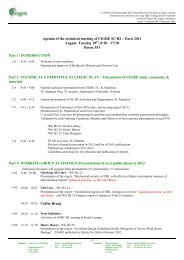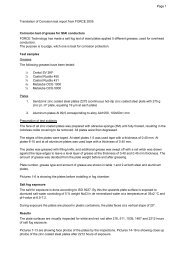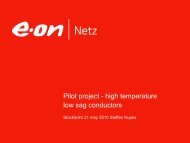Methodology of Ampacity Calculation for Overhead Line - Technical ...
Methodology of Ampacity Calculation for Overhead Line - Technical ...
Methodology of Ampacity Calculation for Overhead Line - Technical ...
Create successful ePaper yourself
Turn your PDF publications into a flip-book with our unique Google optimized e-Paper software.
Page 5 <strong>of</strong> 8IEEE PES Transactions on Power Systems> REPLACE THIS LINE WITH YOUR PAPER IDENTIFICATION NUMBER (DOUBLE-CLICK HERE TO EDIT) < 5123456789101112131415161718192021222324252627282930313233343536373839404142434445464748495051525354555657585960F. Steps 6, 7, 8 and 9The intersection between the sets S ww and S we , i.e.,S w∩e = S ww ∩ S we , results in the following two spans {(20-21),40-41}. When applying the criterion <strong>of</strong> non-dominance on thisset by considering the pairs <strong>of</strong> (wind speed, clearance), it ispossible to realize that these spans have same values <strong>of</strong> windspeed and clearance. As the wind speed is less than the oneconsidered during the overhead line design, new calculations<strong>of</strong> the conductor temperature and consequently <strong>for</strong> theclearance are necessary. After perfoming this calculus theresults obtained are respectively 72.6 (°C) and 9.9 (m). Boththese values violate the limits required by theelectromechanical design <strong>of</strong> this overhead line [70 (°C) and10 (m)].Another alternative analysis to determine the nondominatedset is to plot the data from all spans S ww and S we ina graph <strong>of</strong> wind speed versus clearance, after correcting thetemperature and clearance and taking the non-dominatedpoints. Fig. 5 shows this procedure considering the number <strong>of</strong>spans belonging to S ww and S we . Clearly the same final resultsare obtained, that is, clearance <strong>of</strong> 9.9 (m).Fig. 5. Identification <strong>of</strong> non-dominated spans.G. Step 10: Deterministic Thermal Rating in Critical Spans-ScThe steady-state thermal rating <strong>for</strong> the critical spansdefines the maximum capacity <strong>of</strong> the overhead line. In thismanner, <strong>for</strong> the wind speed <strong>of</strong> 0.9 (m/s) and conductortemperature equal to 70 (°C) from the overhead line design,the maximum capacity results in 0.965 (PU). This result is3.5% smaller than the original ampacity which was calculated<strong>for</strong> the design with wind speed equal to 1 (m/s) and conductortemperature equal to 70 (ºC).This result shows that the overhead line monitoring couldbe done in real time just on the two critical spans. Thismonitoring should be done via sensors <strong>for</strong> measuring theconductor temperature or clearance. This in<strong>for</strong>mation iscertainly <strong>of</strong> great value <strong>for</strong> the company, because the wholeoverhead line monitoring would be much expensive.Of course, more ABL simulations with many winddirection in the boundary condition is worthwhile. Forexample, if more data from ABL simulations are considered,with small angles between adjacent main wind directions,results much more precise are expected. However, the fewsimulations presented in this paper are intended to show theapplication <strong>of</strong> the proposed AmpABL in a real overhead line.This methodology can be applied both during the designand the operation <strong>of</strong> the overhead line. At the design, theproposed methodology allows the designer to get a realisticview <strong>of</strong> the line when the critical spans are found. At theoperation, the AmpABL allows the monitoring <strong>of</strong> these criticalspans. Moreover, applying this methodology, are expected thatboth the reliability and transmission capacity are improved.VIII. CONCLUSIONThe AmpABL methodology was presented in details in thiswork. The core <strong>of</strong> this methodology is the procedure to findthe critical spans which define the overall capacity <strong>of</strong>electrical energy transmission. The methodology was appliedin one real overhead line <strong>of</strong> 138 kV, with 133 spans in theregion <strong>of</strong> Acuruí (southeast-Brazil). This application wasdiscussed step by step to contrast the main characteristics <strong>of</strong>the proposed methodology. The analysis <strong>of</strong> the results firstpointed out that it is possible, after applying the AmpABL, tosupervise the overhead line in real time with small investment(2 critical spans found among 133 ones) and finally that themaximum capacity or thermal rating <strong>of</strong> this overhead linecould be better explored. One expects that this methodology isglobal because the usual way <strong>of</strong> designing overheadtransmission lines is by using the steady-state procedure. Inthis procedure, the allowable maximum conductortemperature, wind speed, weather conditions, <strong>for</strong> the wholeoverhead line, are defined in a conservative way.APPENDIX A – MATHEMATICAL MODEL OF ABLThe mathematical model <strong>of</strong> the ABL is determined byequations (5) to (8). They represent, respectively, conservation<strong>of</strong> mass or continuity equation (5), momentum (6), stateequation (7) and thermal energy (8) based on Reynoldsaveraging and Boussinesq approximation [15], [17], [18].∂u∂xi=i0∂ui+ uj∂t0T 0∂ui∂xj∂ ⎛ δp2 ⎞= −kx⎜ +i 03⎟∂ ⎝ ρ ⎠∂+∂xj⎡ ⎛ ui⎢ ⎜∂νt⎢⎣ ⎝ ∂xj∂u⎞⎤j+ ⎟⎥− S∂xi ⎠⎥⎦δρ δT= −(7)ρ⎛ T T ⎞ ⎛ v ∂T⎞c ⎜∂ ∂ ∂ t+ u ⎟⎟j= ⎜t xj∂xjPrTx⎝∂ ∂⎠ ⎝∂j ⎠p+where u i is i-th mean wind speed component (m/s), δρ thedeviation <strong>of</strong> fluid density from its reference value ρ 0 , ρ 0 thefluid density (kg/m 3 ), δp is the deviation <strong>of</strong> pressure densityQw(5)(6)(8)






